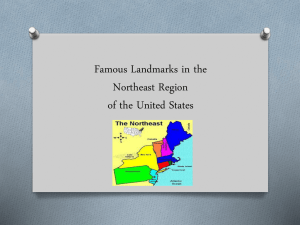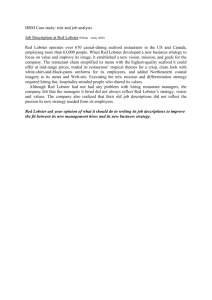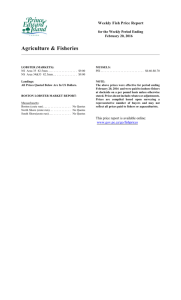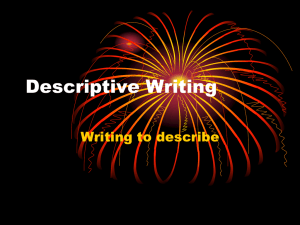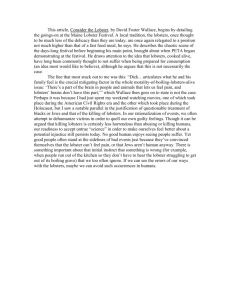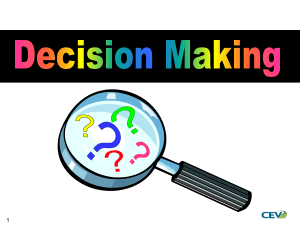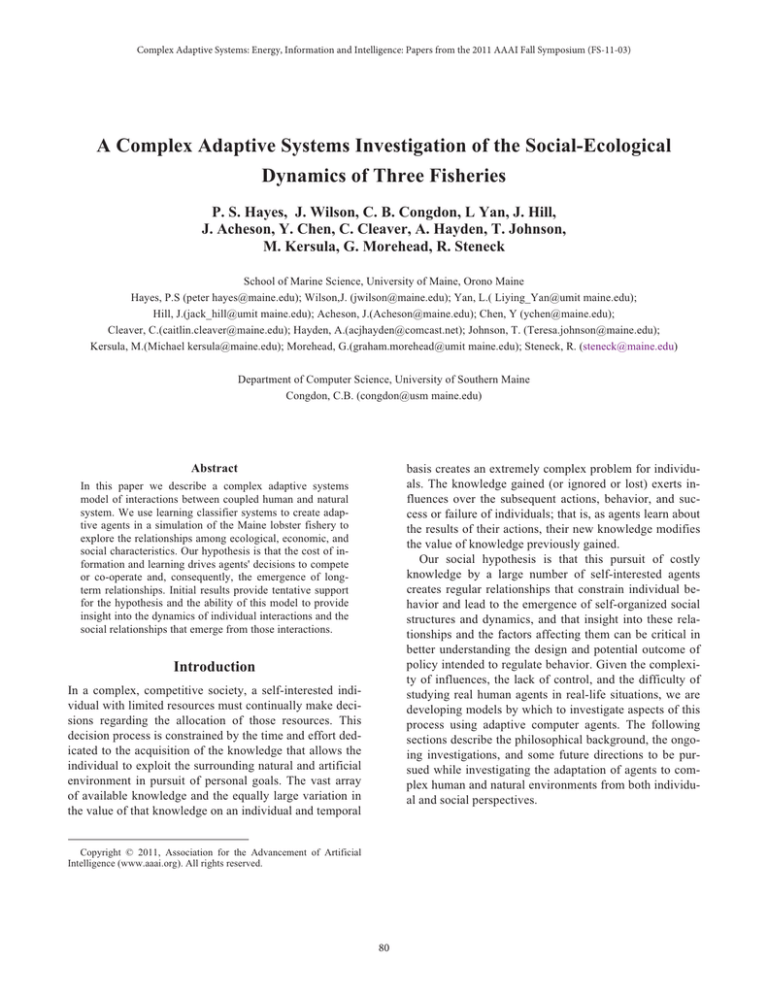
Complex Adaptive Systems: Energy, Information and Intelligence: Papers from the 2011 AAAI Fall Symposium (FS-11-03)
A Complex Adaptive Systems Investigation of the Social-Ecological
Dynamics of Three Fisheries
P. S. Hayes, J. Wilson, C. B. Congdon, L Yan, J. Hill,
J. Acheson, Y. Chen, C. Cleaver, A. Hayden, T. Johnson,
M. Kersula, G. Morehead, R. Steneck
School of Marine Science, University of Maine, Orono Maine
Hayes, P.S (peter hayes@maine.edu); Wilson,J. (jwilson@maine.edu); Yan, L.( Liying_Yan@umit maine.edu);
Hill, J.(jack_hill@umit maine.edu); Acheson, J.(Acheson@maine.edu); Chen, Y (ychen@maine.edu);
Cleaver, C.(caitlin.cleaver@maine.edu); Hayden, A.(acjhayden@comcast.net); Johnson, T. (Teresa.johnson@maine.edu);
Kersula, M.(Michael kersula@maine.edu); Morehead, G.(graham.morehead@umit maine.edu); Steneck, R. (steneck@maine.edu)
Department of Computer Science, University of Southern Maine
Congdon, C.B. (congdon@usm maine.edu)
basis creates an extremely complex problem for individuals. The knowledge gained (or ignored or lost) exerts influences over the subsequent actions, behavior, and success or failure of individuals; that is, as agents learn about
the results of their actions, their new knowledge modifies
the value of knowledge previously gained.
Our social hypothesis is that this pursuit of costly
knowledge by a large number of self-interested agents
creates regular relationships that constrain individual behavior and lead to the emergence of self-organized social
structures and dynamics, and that insight into these relationships and the factors affecting them can be critical in
better understanding the design and potential outcome of
policy intended to regulate behavior. Given the complexity of influences, the lack of control, and the difficulty of
studying real human agents in real-life situations, we are
developing models by which to investigate aspects of this
process using adaptive computer agents. The following
sections describe the philosophical background, the ongoing investigations, and some future directions to be pursued while investigating the adaptation of agents to complex human and natural environments from both individual and social perspectives.
Abstract
In this paper we describe a complex adaptive systems
model of interactions between coupled human and natural
system. We use learning classifier systems to create adaptive agents in a simulation of the Maine lobster fishery to
explore the relationships among ecological, economic, and
social characteristics. Our hypothesis is that the cost of information and learning drives agents' decisions to compete
or co-operate and, consequently, the emergence of longterm relationships. Initial results provide tentative support
for the hypothesis and the ability of this model to provide
insight into the dynamics of individual interactions and the
social relationships that emerge from those interactions.
Introduction
In a complex, competitive society, a self-interested individual with limited resources must continually make decisions regarding the allocation of those resources. This
decision process is constrained by the time and effort dedicated to the acquisition of the knowledge that allows the
individual to exploit the surrounding natural and artificial
environment in pursuit of personal goals. The vast array
of available knowledge and the equally large variation in
the value of that knowledge on an individual and temporal
Copyright © 2011, Association for the Advancement of Artificial
Intelligence (www.aaai.org). All rights reserved.
80
Economic Incentives for an Investigation of
Behavior in Resource Exploitation
Human Decision-making
In a unique effort, our broadly interdisciplinary group has
been developing adaptive agent based models (A-ABMs)
of simple human societies exploiting a complex environment. Our A-ABM differs from regular ABM in that each
agent incorporates a form of machine learning and artificial intelligence – a modified Learning Classifier System
(LCS) – to imbue the agents with individual learning and
adaptation capabilities. This allows agents to learn and to
adapt their behavior in response to interactions with both
the environment and with other agents. This evolutionary
approach changes the domain specific knowledge required of the modeler; instead of requiring knowledge of
the agents conditional adaptive behavior as in conventional models, i.e., the specification of an equation or behavioral rules, the modeler must acquire knowledge about
the kind of information, the actions and the feedback real
world agents use. The evolutionary computation then
searches out well adapted rules.
The settings for the models being developed consist of
three local fishing industries from the Gulf of Maine: the
lobster fishery, the sea urchin fishery, and the groundfish
fishery. A model of the lobster fishery has already been
developed and is being investigated, while models of the
two additional fisheries (and a framework in which to
better implement future models) are being developed. The
three fisheries create very different learning problems for
fishermen and lead to very different social structure.
Facets of these three learning problems have traits
common to all complex human systems, including:
• long-term regularities, particularly at large scales,
in the distribution of a resource, created largely
by ecological factors;
• fine-scale irregularities and variability in distribution, in response to ecological variability and the
actions of the human fishers themselves;
• the opportunity to both compete and cooperate to
achieve goals;
Additionally, agents are provided with the challenges of
adapting to
• a complex knowledge environment in which information may be homogeneous or heterogeneous, ephemeral or durable, local or global in
scope;
• a larger knowledge search space than can be explored by any one agent and encouraging economies in acquisition costs
• a variable value of information due to pathdependency of existing knowledge, complicating
assessment of the value of any particular bit of
knowledge.
These situations are similar to those of all human market participation, while imposing constraints that make
Economists, including Stiglitz (2000), Arthur (1997), and
Hayek (1945), speak of economies and, particularly, markets as responding to information gained from a myriad of
sources. Although the mechanism of this response is not
usually explicit, it is often assumed to involve focused
and conscious learning and adaptation by human participants whose individual actions combine to produce the
aggregate market behavior seen. Hayek (1945) possibly
comes closest to describing a general mechanism by
which markets (and the individuals comprising them) can
incorporate the huge and varied information sources
available. His description involves a hierarchy of nearly
decomposable nested spheres of individual knowledge.
Individuals economize on their knowledge acquisition by
maintaining limited spheres within which their knowledge
level is high and they are well-informed. Outside of these
spheres of knowledge, individuals are not well-informed.
However, the prices and quantities of goods and services
entering and leaving their personal spheres provide the
necessary information by which to act in their own best
interests and to coordinate their activities with others. The
result enables the creation and functioning of even the
large and global markets existing today.
However appealing at an intuitive level, Hayek's description is lacking in details, and provides little insight
into the individual adaptation leading to the markets' selforganized social and economic activities. This 'low-level'
understanding is becoming of increasing importance in
resource management decisions as we come to question
the sustainability of our use of natural resources and realize the significance of fine-scale individual and small
group behavior to the success of policy. Ostrom (1990,
2009) has done path-breaking work on the social and biophysical conditions that facilitate successful collective
action, that is, mutual restraint that sustains the resource
or activity in question. We are interested in the circumstances that create those conditions. In that light we address three important questions:
• How do individuals with limited time and resources learn and adapt selectively to a large,
complex, and competitive environment?
• How do individuals learn and develop restrained
behavior necessary for the emergence of social
structure and dynamics?
• What conditions lead to emerging structures and
dynamics that might contribute to self-governing
resource use or the success of management policies?
Gulf of Maine Fisheries as Exemplars of
81
their simulation more manageable and controllable for the
desired purpose. Simultaneously, they provide the potential for exploring a variety of levels of simulation richness.
mented as strings of bits with three possible conditions –
true (1), false (0), or “don't care” (indicated by '#'). The
last – the “don't care” state – allowed rules to be created
in which one or more of the environmental conditions
provided were inconsequential to the decision – either a
true or false was allowed. Reward in the lobster model
was the catch rate – the number of lobsters caught per trap
– and could take non-integer values.
So far, the XCS/LCS described is fairly standard, a typical use of one of the early AI systems in a slightly unorthodox application. However, the manner of XCS use
within agents to promote learning is where domain
knowledge – knowledge of the fisher's habits and decision
processes – enters and melds with AI to create an adaptive
agent capable of simulating complex human behavior.
The Lobster Fishery as an Example Adaptive
ABM
The existing lobster agent based model was created as
part of a previous project (Wilson et al 2007) and is now
the subject of study and analysis. Its design will be used
to briefly illustrate the characteristics of it and the other
models being developed.
The LCS
The original idea of a Learning Classifier System can be
traced back to John Holland (1986). The LCS used in the
lobster model was actually a modified version of this,
developed by Stewart Wilson (1994, and Butz 2000) and
called an XCS. The XCS is a form of AI consisting of a
set of rules and a series of processes operating on the
rules. Each rule consists of
• a set of conditions representing the environmental
state,
• an action to be carried out in that state,
• an expected reward based on the average of previous rewards under similar circumstances,
• an error representing the deviation of the predicted
payoff from the actual reward,
• a 'fitness' that is dependent on the average accuracy of the rule in predicting the payoff,
• and additional fields necessary for implementing
the LCS algorithms.
The processes that operate on the rules define means of
• selecting an appropriate action based on environmental conditions,
• modifying or creating rules through genetic combination, random mutation, and covering new
conditions,
• selecting those rules best meeting fitness requirements while eliminating rules with poor fitness
as rules are tested through repetition and experience.
The result is a system that provides a general capability
to 'learn' by developing 'fit' rules based on the agent’s
experience of the environment and the reward received. In
many ways, this system follows closely Herbert Simon's
(1955) description of a boundedly rational being learning
about his or her environment and making the best decisions possible with the limited experience and knowledge
available at each decision point.
The XCS used in the original lobster model was a binary version – environmental state conditions were imple-
The Lobster Fisher's Decision
Lobsters are relatively simple creatures; their behavior
can be modeled on the basis of season, water depth, bottom type, and 'exposure' – a measure of the direction of
orientation of an area to the prevailing water activity
(waves, currents, and so forth). An extensive knowledge
of lobster fishers among some of the researchers and interviews with additional fishers revealed that these conditions – all either easily determined by experience or from
nautical charts and other information sources – were the
primary determinants of the location of their traps when
searching for 'good' spots. In addition, real fishers tended
to remember few specific locations and did not usually
use means such as GPS units to mark exact locations.
Instead, they recalled a general area and its characteristics
rather than the latitude and longitude. This general location was embodied in the model by providing an overlay
of the model grid that divided the modeled area based on
the predominant combinations of the above characteristics. The resulting simplified landscape involved 24
zones, eight months of a lobster season, four depth zones,
and three bottom types.
Further complications to an already complex XCS were
introduced by incorporating the social possibilities into
the model. Although fishing is largely a solitary occupation, coffee shops, restaurants, docks, distributors, electronic communications, and chance encounters at sea provide ample opportunity for social interaction. Interviews
indicated that bragging, exaggeration, understatement,
and, sometimes, accurate information were topics of exchange during these encounters, and that comparisons
based on 'interpreted' results of this interchange were a
major means of self-assessment and included questions
such as:
• How am I doing compared to my own best?
• How am I doing compared to what I think others
are doing?
82
• How am I doing compared to what I think is the
best of the others?
• Has my average catch rate changed and, if so,
how?
• How have the catch rates of others changed?
• Should I imitate another fisher and put my trap(s)
in the same location(s)?
These questions were factors of fishers’ behavior and
needed to be included in the model (Wilson et al 2007).
These kinds of assessment appeared similar to the 'satisficing' of Simon (1955) but fit nicely into the paradigm of
a LCS. However, addition of these new states as part of
the human environment complicated the decision process
further and increased the single-LCS learning problem by
orders of magnitude. A solution to this problem was
found by developing a 'hierarchy of decision levels', each
with its own LCS, but each using a reduced set of states.
Different levels allowed either a final decision (an action
to take that resulted in fishing) or an intermediate decision
(to utilize another layer of the hierarchy with different
states) eventually leading to a final decision.
This hierarchical process mirrors that used by humans
in which important, but relatively accessible information,
is often used to either adopt a quick choice or to decide
that more effort is required for a more in-depth analysis
and decision. In our implementation, a socially-oriented,
top-level LCS (the Strategy LCS) incorporates frequentlychanging social criteria and variability in the perception
of relative performance. Simultaneously, this level is accessed at each decision and samples the environment frequently.
A second and third level LCS (the Area and Location
LCS levels) then incorporate the more stable biophysical
aspects of lobster behavior and the environment, and provide the ability to make a more in-depth decision based on
the detailed consideration of past experience in regards to
the conditions displaying more regularity. This hierarchical decision process also led in an exponential decrease
in the search space of each LCS. The result of this design
is shown in Figure 1.
1 -Strategy LCS
Social Interaction as a Choice
Lobster fishers (as well as other fishers) interact during
their meetings in ways that are often competitive, but
sometimes cooperative. Part of our hypothesis is that the
positive feedback created by cooperation can lead to sustained social relationships that can, in turn, form the basis
for successful management. This appears to have occurred
in the Gulf of Maine lobster fishery, which has been operating sustainably for decades under a combination of self
and state management (Ostrom 2009). In order to investigate the causes of success and failure, the social interaction needed to be part of the model and incorporated as
part of the agent's learned choices.
This was implemented as an action available in the toplevel LCS (the Strategy LCS) that allowed one agent to
imitate or copy another, laying a trap at the location of the
other's recent traps. The decision to imitate is one in
which the opportunity cost – either using one's own
knowledge or exploring new territory to receive a reward
– might be considered in light of the perceived benefit of
imitating a particular agent. That perceived benefit would
depend on factors influencing the other agent's perceived
performance, determined by what was 'heard' about that
agent (personal encounters, distributor conversations, the
coffee-shop chatter, and so forth) modified by familiarity
with that agent obtained through personal encounters.
The binary made representation of such complicated
perceptions difficult. The implementation used in the lobster model was to weight the catch rate of another agent
by a factor dependent on the relative frequency with
which that agent was encountered. This simulated the
sense of ‘familiarity’ developed between pairs of agents.
The best weighted catch rate of any other agents was then
compared to the agent’s own catch rate and the comparison – a binary ‘greater than’ or ‘less than or equal to’ –
registered as an environmental condition in the Strategy
LCS.
Imitation consisted of the imitating agent adopting a location of and setting its trap near one of the imitated fisher's traps. At that point, the biophysical conditions at that
location were incorporated as a new imitating agent's rule
in the lower two LCS levels, available from then on as
any other rule and receiving reward according to performance. In many regards, this is an additional rule creation
process of the LCS (although it is largely performed external to the LCS).
Stay, local search, imitate
Performance & Agent Info.
New
Loca ion
Environment
2 - Area LCS
General Area, Season
New
Loca ion
3 - Location LCS
Some Preliminary Results of the Lobster
Model Analysis
Characteristics of new location
Biophysical Details, Season
Analyzing the results of the lobster model is an ongoing
Figure 1: Decision hierarchy of agent.
83
effort and is leading to additional insight into areas such
as the model design, the outputs and information from the
model that should be made available, and the limitations
of various analysis techniques when dealing with the
complex system formed by the model. We present below
some of the results in which we have confidence, some
suggestions of interesting phenomena, and – particularly
in the next section of future work – some of the lessons
learned.
A second comparison made was to plot the lobster
catch rate as a function of time over a season; monthly
catch rates for the eight-month season are shown in Figure 3. Again, this agrees well with similar plots of real
catch rates, and confirms the adaptation of the simulated
fishers to the biophysical conditions. In our model, the
decreasing catch rate demonstrates a depletion of lobsters
as the season progresses.
Basic Comparisons with Reality
The Maine Department of Marine Resources (DMR) recruited lobster fishers to participate in a program of detailed monitoring in which the location, time, and success
of trap hauls was carefully recorded. The resulting database provides nearly a million trap hauls from forty-four
lobster fishers over three years and provides the basis for
a first comparison of model results with actual performance.
A first measure of performance is the efficiency – the
number of trap hauls required to achieve a given production. While absolute value will vary with fisher, location,
abundance, and other variables, a telling indicator is the
variation of that rate over the months of the fishing season
as lobsters perform a seasonal migration and molt new
shells. In the real world, this impacts the locations and
catchability of lobsters. In the model, this is simulated by
a variable catchability factor simulating the availability of
lobsters in different habitats at different times of year.
Maintaining efficiency in both situations means that fishers must learn to anticipate lobster movement and depletion due to others’ fishing. In the model, as in the real
world, comparison with nearby competitors leads to a
continual jostling of trap locations in search of favorable
catch rates as fishers compete in relative performance,
resulting in agent adaptation to the lobster environment
and a relatively constant haul-per-lobster ratio as illustrated in Figure 2.
Figure 3: Individual Catch Rates (Lobster/Trap Haul) vs
Month of Season, demonstrating a reasonable adaptation
to changing lobster habitat.
Social Comparisons
A major component of our interest in creating the model
was the potential for studying the formation of social relationships among fishers and the factors affecting those
relationships. While we know of no direct or quantitative
comparisons with reality that might be used, we know that
the social component exists in the real lobster fishery and
that the competitive and cooperative actions of participants have served to create, maintain, and enforce a comanagement regime with the state that has helped sustain
the lobster fishery in Maine.
In keeping with our basic hypotheses that cooperation
can help create the basis of this kind of co-management,
we have concentrated largely on investigating the networks formed by cooperating individuals who, in the
model, form imitating pairs. The model maintains a sociomatrix of imitations that is written to an output text file
each year so that, at the end of a typical 50-year model
run, there are 50 NxN matrices, showing in the ith row
and jth column the cumulative number of times agent i
imitates agent j for all model time up to the end of that
harvest year.
In general, imitation appears to be a productive tactic
for learning about the environment and is relatively popular as a selected action in the top-level LCS. However, the
distribution of imitations is not uniform at all. A 'typical'
run is shown in Figure 4 from two perspectives. First, all
Figure 2: Trap Hauls (vert. axis) vs Lobsters Hauled (hor.
axis, demonstrating nearly constant efficiency.
84
imitations are shown (agents are small circles, arrows
indicate the imitations, arrow width is proportional to the
number of imitations); next, only those imitations of
greater than one per year are shown.
that result briefly mentioned earlier. However, our postdevelopment work on this model has provided experience
in the kinds of information desired and the capabilities
that an 'ideal' model developed for these purposes might
possess and rewriting has begun on a new iteration alleviating some of the flaws found in the now aging original.
Additional Fisheries: Sea Urchins and Groundfish
Two additional fisheries will be modeled in a similar
manner. The sea urchin and the groundfish fisheries in the
Gulf of Maine present very different characteristics from
those of the lobster fishery while still remaining within
the bounds that we might interpret as meeting our overall
objectives (as described earlier). Urchins represent an
even more sedentary resource than lobsters while groundfish are now recognized as comprising numerous mobile
populations with a more limited predictability. Both fisheries are in the process of being developed for modeling
using adaptive agents similar to those of the lobster model. The process is similar and consists of
• a round of in-depth interviews with fishers from the
industry, researchers, and managers involved in setting
policy for the industry;
• transcription of the interviews while distilling aspects
significant for simulating the biophysical environment,
the social environment, and the decision hierarchy of the
fishers;
• discussion regarding the model design and the start of
the design, especially the biophysical aspects and the decision hierarchy;
• a second round of interviews with some of the same
individuals to better answer questions arising from the
previous activities and to propose the basic solution to
those in the industry for feedback;
• implementation and tuning of the model;
• analysis and exploratory investigation of results.
The urchin model is the more advanced of the two and
has reached the stage of a biophysical model realizing a
critical tripping point recognized by both researchers and
fishers alike. Urchins, being sedentary, colonize ledges
just beneath the low-tide mark (and at lower depths, but
with greatly reduced health, nutrition, fertility...). When
present, the urchins feed on algae growing on the ledge
substrate, keeping algae length short and abundance
sparse. When removed from the ledge by a diver during
harvesting, algae begin to grow to cover the now barren
rock. Urchins (from depths at which they were surviving
in poor health or from larvae deposition) may re-colonize
the ledge and continue feeding on the growing algae.
However, without a nearby population of urchins, and
under other conditions leading to high algal growth rates,
the algae may grow fast enough to provide shelter for
Figure 4: Network diagram showing (left) all imitations and (right) only those > once per year. (Note:
placement of vertices in the graphs has no significance,
being simply a characteristic of the display algorithm.)
As is obvious, the frequency of imitation varies dramatically among pairs of agents, with a low level (less than
one per year) of imitation occurring between almost all
pairs, but much more prevalent imitation (up to several
thousand imitations over a 50-year run) occurring among
some small groups of agents. This is consistent with the
types of networks formed by participants in the actual
lobster industry where fishers from the same harbor have
some closely-knit relationships and other, less-friendly
ones, lending credence to the use of this type of model for
exploration of human behavior.
On the cautionary side, we have recently determined
that the model’s implementation of imitation leads to a
significant positive feedback and strong path dependence
on early conditions in the agents chosen for imitation. We
are investigating alternate implementations of the imitated
agent selection algorithm in an effort to better understand
the present results. Still, despite the strong path dependency that we believe is problematic, there are other tantalizing hints of support for the hypothesis and the ability of
these types of models to simulate aspects of human behavior and adaptation, leading us to optimistically pursue
continued investigations in this direction.
Ongoing Investigations and Future Work
The Lobster Model
Investigations continue using the lobster model simultaneously with many of the other efforts. Of particular interest is the implementation of the potential for cooperation within the model and the emerging social patterns
85
small urchin predators (primarily crabs) that can dramatically reduce urchin abundance or even prevent urchin
recolonization. This constitutes a 'flip' or trigger point for
the ledge and is a characteristic realized by and to be explored using the urchin biophysical model.
The groundfish model is at an earlier stage. A number
of initial interviews have been performed, transcription
done, and discussion begun based on the first round of
interviews. Although concepts have been developed for
the model (both biophysical and fisher) they have not
been coded or finalized.
In both cases, work has been a cooperative effort of the
interdisciplinary team – including anthropologists, biologists, computer scientists, ecologists, economists, sociologists, and statisticians as primary or temporary members
– and results in detailed descriptions of the decision hierarchy to be implemented. Representational details of environmental characteristics, the actions to be provided, rewards to be given, are all discussed at smaller group
meetings, and reviewed at project meetings. The belief is
that the ultimate product will incorporate the knowledge
and expertise of all pertinent domain experts.
Acknowledgments
The authors would like to thank the many members of the
faculty of the University of Maine and the University of
Southern Maine who have provided us assistance in this
endeavor. We also wish to thank the many persons contributing to this project in less formal ways, through conversations, suggestions, and, especially, to those who
work in the Gulf of Maine fisheries and whose willingness to share both data and their thoughts and strategies
have helped make this project possible. Finally, we wish
to express our gratitude to the NSF for sponsorship of this
effort and to the NOAA NMFS Sea Grant for both their
sponsorship of the original modeling work and their continued fellowship support for team members.
References
Arthur, W. et al, 1997 “Asset Pricing Under Endogenous Expectations in an Artificial Stock Market”, Santa Fe Institute Working Paper
Butz,M.V. & Wilson, S.W. 2000 “An algorithmic description of
XCS,” lliGAL Report No. 2000017, April, 2000
Holland, J.H. 1995 “Hidden Order: How Adaptation Builds
Complexity”, Perseus Books Group, Cambridge, 1995
Holland, J.H. et al, 1986 “Induction: Processes of Inference,
Learning, and Discovery”, MIT Press, Cambridge, 1986
Mason, 2011 Multi Agent Simulator of Neighborhoods library,
http://cs.gmu.edu/~eclab/projects/mason/
Ostrom, E.; 1990; Governing the Commons: The Evolution of
Institutions for Collective Action.; New York: Cambridge University Press.
Ostrom, E.; 2009 “A general framework for analyzing sustainability of social-ecological systems”, Science, vol. 325, pp419422
Simon, H. “A behavioral model of rational choice”, The Quarterly Journal of Economics, vol. 69, no.1, pp99-118, 1955
Stiglitz, J. 2000. The Contributions of the Economics of Information to Twentieth Century Economics. Quarterly Journal of
Economics. pp. 1441-78.
Wilson, J, et al 2007 "The precursors of governance in the
Maine lobster fishery". Proceedings of the National Academy of
Sciences of the United States of America, September 25, 2007.
Vol 104:39
Wilson, s. 1994 “Classifier fitness based on accuracy”, Evolutionary Computation, 1994, vol. 3, no. 2
A Framework for Future Models
Mentioned briefly earlier, a list of issues, desirable traits
and abilities, and some necessary changes were found as a
consequence of our investigation of the original lobster
model. Primary among these was the recognition that, as
the product of many years of development with changing
goals, its lifetime was nearing an end. One goal of our
continued efforts was to implement a framework to facilitate the creation of new models in the future. After some
initial investigation and reviews, we have begun writing
wrapper classes around the Mason (Mason 2011) ABM
framework to better customize it for our applications.
While keeping the benefits of Mason, our wrappers will
provide a very flexible configuration capability from simple text files (for those familiar with it, the ECJ Parameter
Database classes are being used and minimally extended),
easy creation and provision of I/O capabilities, increased
modularity and looser coupling between modules, and
greater flexibility in the areas of the environment and
provision of 'observer' objects that can fulfill functions
common to all agents (such as a common social structure,
a marketplace, and so forth). In addition, a configurable
integer-based XCS has been added as part of the utilities
provided (alternative decision mechanisms may be added
as desired).
As with most software, experience will surely prove
this to be less than perfect, but we believe it will provide a
suite of needed capabilities making implementation and
investigation of adaptive agent-based models such as these easier and faster in future efforts.
86

